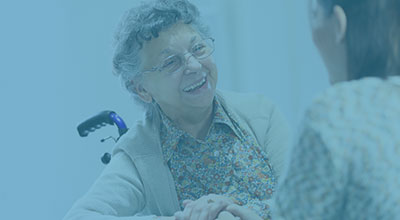-

Where do current lighting solutions fall short and what needs to be addressed?
Lighting in Healthcare
-

Enhanced fluorescent light intensity shows some but limited benefits on neuropsychiatric behaviour
-

The particular importance of human-centric lighting for Nursing homes
Strong intensity light can alleviate depression, SAD, Seasonal Affective Disorder.
Reports show a dose-response relationship for morning light in SAD patients for typical but not atypical symptoms, with strong light (6,000 lux and more) being more effective than medium light (1,700-3,500 lux) or dim light (600 lux and less). Time of day evaluation of bright light therapy for non-seasonal depression showed that morning exposure was more effective than at any other time of day, and this was equal between groups with and without concomitant drug therapy. This indicates that light intensity applied in the morning has different therapeutic effects on typical mood symptoms. Bright light therapy (10,000 lux) in comparison to medium (4,000 lux) or dim light (50 lux), applied in the morning as adjunct treatment, increases the antidepressant effects of SSRIs such as sertraline and citalopram in patients treated for depression. Light therapy in the form of a dawn simulation in non-seasonal depression showed similar effect sizes but here no dose-response relationship was carried out. The effect sizes for light therapy are equivalent to those in anti-depressant pharmacotherapy trials.
Conclusion: Bright light treatment of 10,000 lux can treat seasonal and non-seasonal depression and increases the antidepressant effects of SSRIs such as sertraline and citalopram.

Enhanced fluorescent light intensity shows some but limited benefits on neuropsychiatric behaviour
Read more...
Enhanced fluorescent light intensity shows some but limited benefits on neuropsychiatric behaviour.
The individual trials varied in the modalities of the light therapy but numbers were too small to allow for subgroup analyses that would determine, which modality, (type, intensity, duration, time-of-day) might be beneficial for specific types and severity of dementia. Increased indoor light intensity in care homes as a treatment for sleep problems, including sleep onset latency, sleep efficiency and night-time awakenings showed a similar trend of low efficacy and considerable variability between studies. However, a double-blind, long-term study included in the meta-analysis has shown a modest benefit of bright light therapy in improving day-time activity and some cognitive and non-cognitive symptoms of dementia. Other comparative studies and clinical trials showed that increased light levels reduced day-time sleepiness.
Conclusion: There is very limited evidence to show that light therapy decreases the decline in cognition or decreases agitation and psychiatric symptoms. However, there is a modest benefit of bright light therapy in improving day-time activity and some cognitive and non-cognitive symptoms of dementia.
Where do current lighting solutions fall short and what needs to be addressed?
In addition to meeting the age-related demands with increased illumination, aspects of light’s non-image forming effects on mood, cognition, alertness, sleep and internal rhythms, can and should be implemented in future designs of healthcare buildings. In particular, those of daylight exposure and dynamic lighting systems need to be considered. Ideally, building and indoor designers need to consider the direction of natural light, glass structures and proportions of window surfaces to allow maximising natural light exposure. Special lighting solutions for individual rooms with different purposes (recovery or emergency rooms in a hospital, bed rooms or day-activity rooms in nursing homes), should be programmed to be remotely user-tuneable by staff, patient, resident or carer. Being in control of the environment increases independence, confidence and a positive attitude in individuals that is beneficial for the mood and any healing process.
Conclusion: Older people need more light to secure proper visual performance.
Being in control of the environment increases independence, confidence and a positive attitude in individuals that is beneficial for the mood and any healing process.
The particular importance of human-centric lighting for Nursing homes.
The temporal 24-hour light-dark exposure becomes very important for the repair and regeneration of cells, because cell cycles are dependent on strong signals from the body clock, whose activity is influenced by light quality, intensity and timing. Therefore, personalised dynamic light settings for each room in hospitals and care homes should be propagated. For example, dynamic light can include a dawn simulation, a cool light colour temperature that fluctuates with warmer colour temperature over the course of the day, and an absence of cool colour temperature in the evening. Furthermore, in a hospital, if possible, a patient should be allowed to adjust light levels in the room by shading daylight, dimming ceiling light from cool to warm colour temperature and having spot lights for reading or getting up at night.
Conclusion: Patients should be able to control the light levels in the room and the colour temperature. This will support the healing process and enhance quality of life for the patients.




